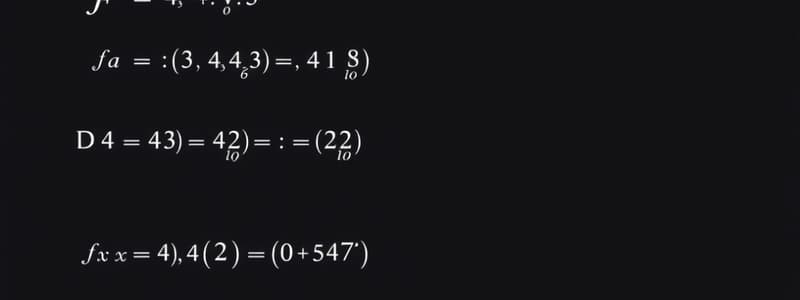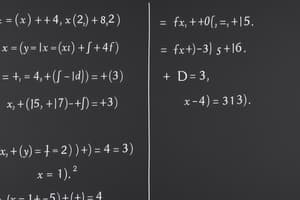Podcast
Questions and Answers
What is the domain?
What is the domain?
x-values (left and right)
What is the range?
What is the range?
y values (min and max)
What is interval notation?
What is interval notation?
Represents a set of real numbers with a pair of values that are its left (minimum) and right (maximum) boundaries.
How do you find the x-intercept?
How do you find the x-intercept?
How do you find the y-intercept?
How do you find the y-intercept?
What is the zero of a function?
What is the zero of a function?
What is the x-intercept?
What is the x-intercept?
What is the y-intercept?
What is the y-intercept?
What is the maximum of a function?
What is the maximum of a function?
What is the minimum of a function?
What is the minimum of a function?
How do graphs and equations reveal information about a relationship between two quantities?
How do graphs and equations reveal information about a relationship between two quantities?
What is a vertex?
What is a vertex?
What is the axis of symmetry?
What is the axis of symmetry?
What is reflection in terms of functions?
What is reflection in terms of functions?
What is a positive graph?
What is a positive graph?
What is a negative graph?
What is a negative graph?
Flashcards are hidden until you start studying
Study Notes
Key Features of Functions
- Domain: Refers to all possible x-values that a function can take. It represents the left and right boundaries of the graph.
- Range: Represents the set of possible y-values, indicating the minimum and maximum heights of the function.
- Interval Notation: A mathematical notation that expresses a set of real numbers using a pair of values; the left boundary (minimum) and the right boundary (maximum).
- Finding X-Intercepts: To identify x-intercepts, set y equal to zero; the corresponding x-values are where the graph intersects the x-axis.
- Finding Y-Intercepts: To find y-intercepts, set x equal to zero; the resulting y-values are where the graph intersects the y-axis.
- Zero of a Function: The x-value(s) that make the function output zero (f(x) = 0); these values are crucial for understanding where the graph intersects the x-axis.
- X-Intercept: The specific x-coordinate of points where the graph crosses the x-axis.
- Y-Intercept: The specific y-coordinate of points where the graph crosses the y-axis.
Function Behavior
- Maximum: The highest point on the graph, indicating the transition from increasing to decreasing values.
- Minimum: The lowest point on the graph, indicating the transition from decreasing to increasing values.
- Graph and Equation Relationship: Graphs and equations illustrate how variables x and y are interconnected. Changes in x affect y, typically represented as y = f(x), depicting the function's rule of connection.
Additional Key Concepts
- Vertex: The apex or lowest point of a graph, significant in determining the function's overall shape.
- Axis of Symmetry: A line that divides the function into two identical halves, displaying symmetrical properties.
- Reflection: A transformation that flips points across a specified line, creating a mirror image of the original graph.
- Positive Graph: Portions of the graph that lie above the x-axis, indicating positive y-values.
- Negative Graph: Portions of the graph that lie below the x-axis, indicating negative y-values.
Studying That Suits You
Use AI to generate personalized quizzes and flashcards to suit your learning preferences.




